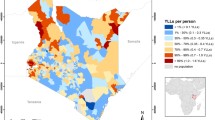Abstract
This unique study illustrates the potential application of Geographic Information Systems (GIS) to generate hypotheses regarding which African great ape populations, including bonobos (Pan paniscus), chimpanzees (Pan troglodytes), and gorillas (Gorilla gorilla and Gorilla beringei), are at increased risk from human diseases. Human demographic data and core human health indicator data for the African great ape range countries were obtained. Human population density and percent annual human population growth rate were used as combined indicators of environmental stress/vulnerability (as a proxy measure of human–great ape contact), and infant mortality rate (IMR) and healthy life expectancy (HALE) were used as separate indicators of disease burden among the human populations living in the great ape range countries. Cut-off values were determined and, using GIS, these indicators were analyzed to create maps of critical areas (countries) with both environmental stress and high burden of human diseases. When using IMR as the indicator of disease burden, the great ape range countries identified as critical areas included Benin, Guinea-Bissau, Ivory Coast, Liberia, Nigeria, and Tanzania. Cameroon and Uganda were also identified as critical areas when using HALE as the indicator of disease burden; however, Benin was excluded. Validation of these results would allow for targeted interventions thereby maximizing the use of limited resources. Improvements in public health infrastructure in these critical areas would benefit the human populations that have unmet health needs as well as these endangered species.



Similar content being viewed by others
References
Adams HR, Sleeman JM, Rwego I, New JC (2001) Self-reported medical history survey of humans as a measure of health risk to chimpanzees (Pan troglodytes schweinfurthii) of Kibale National Park, Uganda. Oryx 35:308–312
Goodall J (1971) In the Shadow of Man, Boston: Houghton Mifflin
Graczyk TK, Mudakikwa AB, Cranfield MR, Eilenberger U (2001) Hyperkeratotic mange caused by Sarcoptes scabiei (Acariformes: Sarcoptidae) in juvenile human-habituated mountain gorillas (Gorilla gorilla beringei). Parasitological Research 87:1024–1028
Guerrera W, Sleeman JM, Ssebide BJ, Pace L, Ichinose TY, Reif JS (2003) Medical survey of the local human population to determine possible health risks to the mountain gorillas of Bwindi Impenetrable Forest National Park, Uganda. International Journal of Primatology. 24:197–207
Kalema-Zikusoka G, Kock RA, Macfie EJ (2002) Scabies in free-ranging mountain gorillas (Gorilla beringei beringei) in Bwindi Impenetrable National Park, Uganda. The Veterinary Record 150:12–15
Leendertz FH, Ellerbrok H, Boesch C, Couacy-Hymann E, Matz-Rensing K, Hakenbeck R, et al. (2004) Anthrax kills wild chimpanzees in a tropical rainforest. Nature 430:451–452
Leroy EM, Rouquet P, Formenty P, Souquiere S, Kilbourne A, Froment JM, et al. (2004) Multiple Ebola virus transmission events and rapid decline of central African wildlife. Science 303:387–390
Murray CJ (1988) The infant mortality rate, life expectancy at birth, and a linear index of mortality as measures of general health status. International Journal of Epidemiology 17:122–128
Pan American Health Organization (2000) Geographic Information Systems in Health, Basic Concepts, Washington DC: Special Program for Health Analysis, Pan American Health Organization
Reidpath DD, Allotey P (2003) Infant mortality rate as an indicator of population health. Journal of Epidemiology and Community Health 57:344–346
Walsh PD, Abernethy KA, Bermejo M, Beyers R, De Watcher P, Akou ME, et al. (2003) Catastrophic ape decline in western equatorial Africa. Nature 422:611–614
Author information
Authors and Affiliations
Corresponding author
Rights and permissions
About this article
Cite this article
Sleeman, J.M. Disease Risk Assessment in African Great Apes Using Geographic Information Systems. EcoHealth 2, 222–227 (2005). https://doi.org/10.1007/s10393-005-5876-y
Published:
Issue Date:
DOI: https://doi.org/10.1007/s10393-005-5876-y




